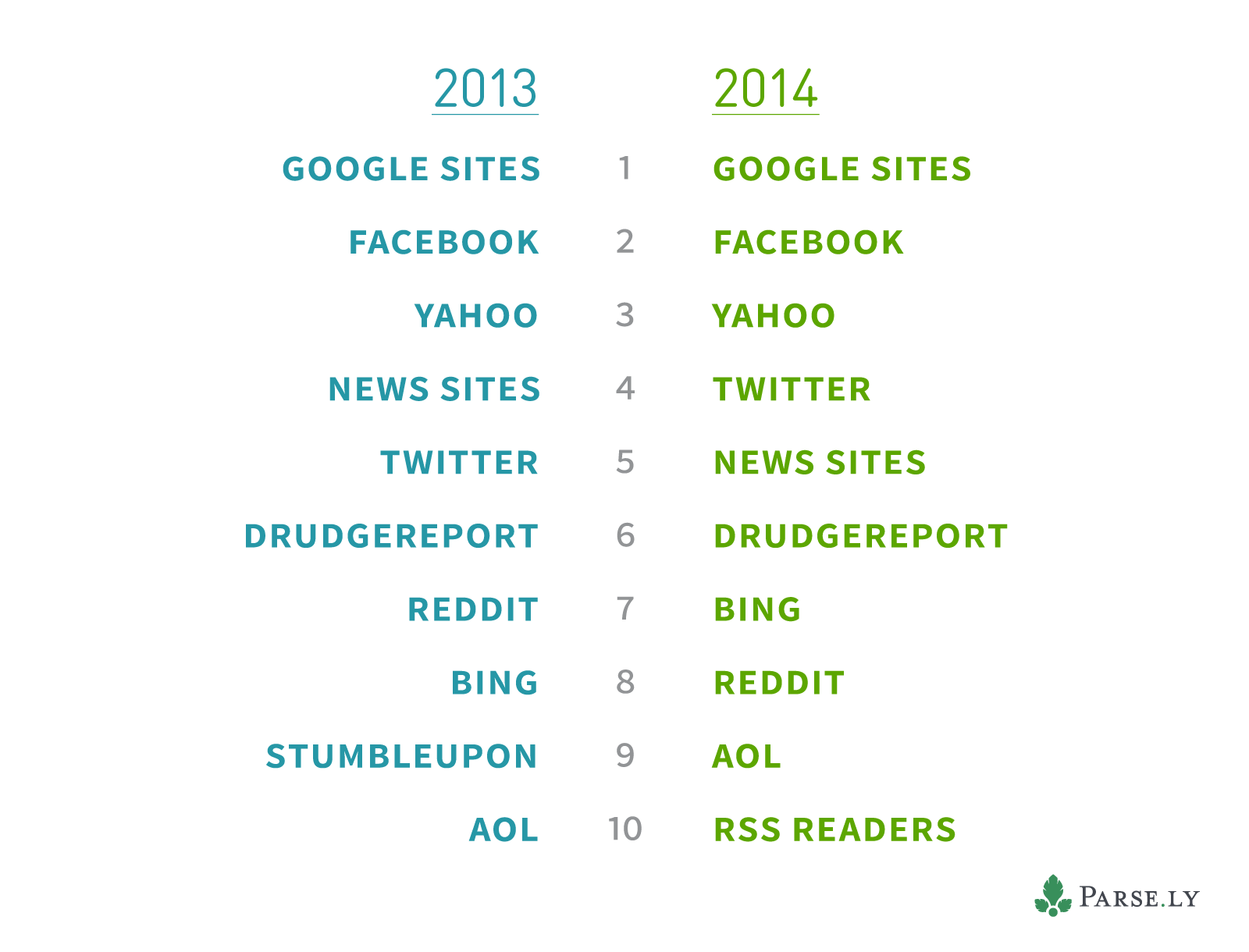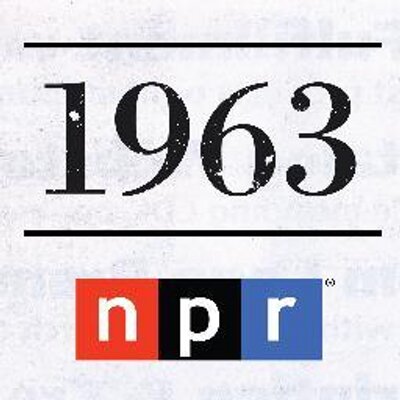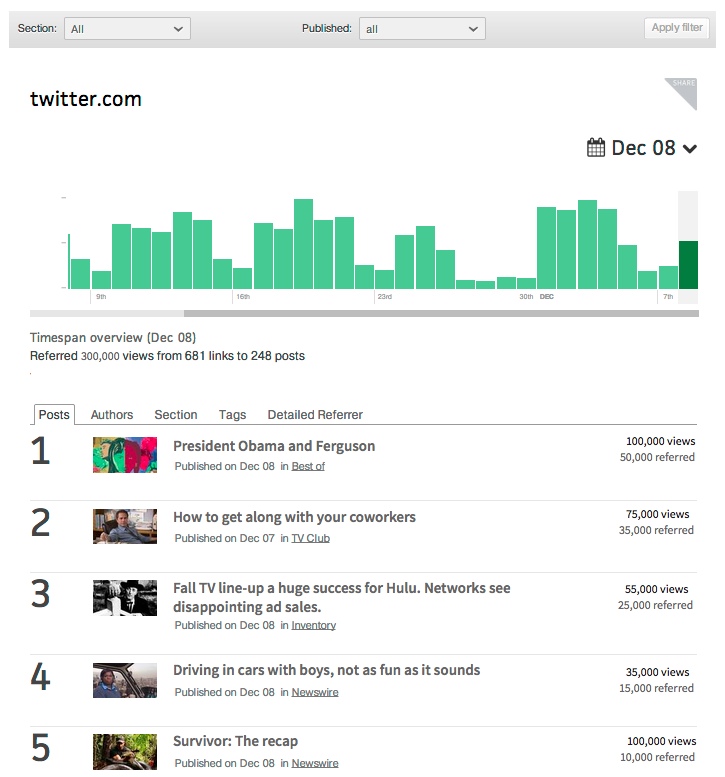Mark Luckie: How Media Companies Should be Using Twitter
A never-ending, real-time conversation about the stories media companies cover happens every day on Twitter. Social media editors, and editorial teams in general, now have the opportunity to use these conversations to find news, put stories into context, interact with their readers and find new audiences. Parse.ly brought in Mark Luckie, Manager of Journalism & News at Twitter, to show off how to make the most of Twitter at a news or media organization.
The results can make a big difference; according to our aggregate audience data, Twitter accounts for the fourth biggest aggregate source of referral traffic to digital publishers’ sites. And its influence continues to grow: Twitter moved up one spot in our rankings from 2013.

See the full list by subscribing to the Parse.ly Authority Report.
The huge volume of tweets that get sent every day helps explain why Twitter ranks so high on that list. Users send 1 billion tweets every two and a half days.
How can you cull through that volume to distribute news and reach readers? And what are some ways you can search through those billions of tweets to find sources or story angles? Here are some of Mark’s suggestions:
Be Smart, Not First: Don’t publish information on Twitter you haven’t verified
Luckie emphasized that media brands don’t need to be the first to tweet to make an impact. “If you don’t have a story ready, let people know you’re working on it, and link to archival content,” he recommended. Letting your audience catch up with the background of a breaking story can help give them context when your content goes live.
Don’t just distribute your links: Use Twitter as a source for journalism

Luckie showed off a few private beta products that Twitter is offering to media and brands, including a system for filtering and saving tweets based on topics. He’s hoping social media editors will use it to create content. He used a live demo to create a Twitter collection that could be placed in a story or used during a broadcast in real time. The filters looked like Tweetdeck on steroids. In addition to the product’s extensive search capabilities, it also gives immediate access to the tweet volume and frequency for topics.
A great example of going beyond the embedded tweet is the NPR project @todayin1963. Coordinated by Kat Chow, this Twitter account tweets events from the year 1963, as if they were happening right now.
Engage, engage, engage: Twitter is a two-way communication platform for readers and publishers
The real-time nature of Twitter allows for interaction directly with readers and followers in a way that isn’t possible on most media and news websites. Luckie pointed out a few ways to harness this, starting with a benchmark for publishers to check how they’re doing compared to their cohort. The average engagement rate for media brands hovers around 4%, Luckie told us. (You can check you numbers in Twitter’s analytics.)
Need to bring your numbers up? Every successful account does these five things:
- Retweet other accounts
- Reply to followers, mentions
- Use #hashtags
- Incorporate photos and videos
- Live tweet events, AMAs, Q&As, and more
Focus on a few areas: How not to get overwhelmed by Twitter
One of our clients voiced a common concern: “If I start using Twitter, won’t I constantly need to be monitoring and engaging on it?” For those just starting out, Luckie recommended retweeting readers that share your stories and those already fans of your brand.
Need to find these people? Besides searching for mentions, use your Parse.ly account to figure out which stories are getting shared the most and who’s sharing them.
Visit the Twitter referral page in your Parse.ly account for a snapshot of the top stories:

The detailed referrer tab will point you directly to the tweets that drove the most traffic to each story.
Use Stats to Your Advantage: The best times to post to Twitter*
8-10 am: People wake up and want to see the morning news while they commute, drink their coffee, and before they have to go to meetings or start work.
12-2 pm: While people eat lunch and take a work break, they gravitate towards lifestyle, pop culture, and other fun things topics.
5-8 pm: Users are at home and watching television. Television and live tweeting have become very popular (#peterpanlive anyone?)
Along with the best times, Luckie recommended tweet frequency for media companies. The most engaged accounts send a tweet every 18-20 minutes during the day and less on nights or weekends when 30 min – 1 hour is plenty. Don’t have overnight desks around the world? Use scheduled tweets to interact with international Twitter users (or insomniacs!).
*We recommend checking your own data before applying any common strategy; your audience may differ.
Be a human.
Twitter relies on relationships. We’ll sum it up with the most appropriate media available: a tweet!
Key to twitter success from @marksluckie … Be a human on twitter, not a robot #realtalk #parselytwitter pic.twitter.com/IHvzR7oA0b
— R. Stefan Deeran (@RStefanDeeran) December 4, 2014
How does your social media team use Twitter? Leave any other tips or questions with (what else?) the Twitter hashtag #parselytwitter.
Image via flickr.